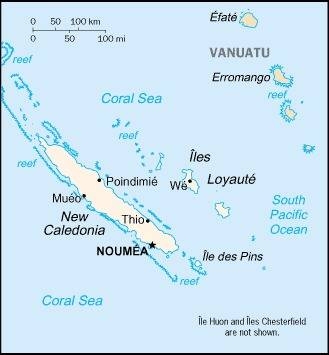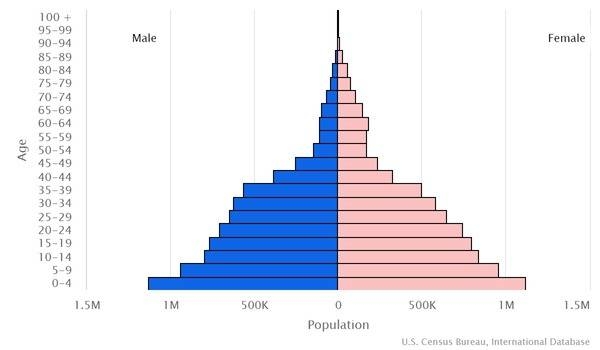Country Summary




Introduction
Background
The Lapita, skilled navigators, first settled in New Caledonia around 1600 B.C. British explorers arrived in 1774. In 1853, France annexed New Caledonia. During World War II, New Caledonia became an important base for Allied troops. In 1953, French citizenship was granted to all inhabitants.
Geography
Area
total: 18,575 sq km
land: 18,275 sq km
water: 300 sq km
Climate
tropical; modified by southeast trade winds; hot, humid
Natural resources
nickel, chrome, iron, cobalt, manganese, silver, gold, lead, copper
People and Society
Population
297,160 (2022 est.)
Ethnic groups
Kanak 39.1%, European 27.1%, Wallisian, Futunian 8.2%, Tahitian 2.1%, Indonesian 1.4%, Ni-Vanuatu 1%, Vietnamese 0.9%, other 17.7%, unspecified 2.5% (2014 est.)
Languages
French (official), 33 Melanesian-Polynesian dialects
Religions
Christian 85.2%, Muslim 2.8%, other 1.6%, unaffiliated 10.4% (2020 est.)
Population growth rate
1.19% (2022 est.)
Government
Government type
parliamentary democracy (Territorial Congress); an overseas collectivity of France
Capital
name: Noumea
Executive branch
chief of state: President Emmanuel MACRON (since 14 May 2017); represented by High Commissioner Patrice FAURE (since 6 June 2021)
head of government: President of the Government Louis MAPOU (since 22 July 2021); Vice President Isabelle CHAMPMOREAU (since 22 July 2021)
Legislative branch
description: unicameral Territorial Congress or Congrès du Territoire (54 seats; members indirectly selected proportionally by the partisan makeup of the 3 Provincial Assemblies or Assemblés Provinciales; members of the 3 Provincial Assemblies directly elected by party-list proportional representation vote; members serve 5-year terms); note - the Customary Senate is the assembly of the various traditional councils of the Kanaks, the indigenous population, which rules on laws affecting the indigenous population
New Caledonia indirectly elects 2 members to the French Senate by an electoral colleges for a 6-year term with one seat renewed every 3 years and directly elects 2 members to the French National Assembly by absolute majority vote in 2 rounds if needed for a 5-year term
Economy
Economic overview
upper-middle-income French Pacific territorial economy; large tourism presence that was hit hard by COVID-19; nickel and other metals mining operations; continuing French subsidies; large exporter of nickel to China
Real GDP (purchasing power parity)
$11.11 billion (2017 est.)
Real GDP per capita
$31,100 (2015 est.)
Agricultural products
coconuts, vegetables, maize, fruit, beef, pork, potatoes, bananas, eggs, yams
Industries
nickel mining and smelting
Exports
$2.207 billion (2014 est.)
Exports - partners
China 59%, South Korea 14%, Japan 11% (2019)
Exports - commodities
iron alloys, nickel, cobalt, carbonates, essential oils (2019)
Imports
$2.715 billion (2015 est.)
Imports - partners
France 43%, Australia 12%, Singapore 12%, China 6% (2019)
Imports - commodities
refined petroleum, aircraft, coal, cars, packaged medicines (2019)
Exchange rates
Comptoirs Francais du Pacifique francs (XPF) per US dollar -
Page last updated: Thursday, July 28, 2022
